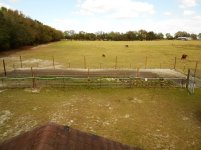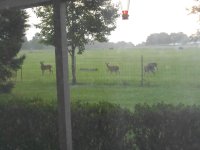Some thoughts, I'm icing my hands after spending the day putting up fence!
My experience is with woven wire instead of welded. I've never worked with good quality welded so I don't know how much of this transfers. The thing to keep in mind is that if you have dips and hills the top of the fence travels a different distance than the bottom. With woven wire, you have to stretch it to install it, so if you stretch it from the top and bottom separately they can be different distances. With woven wire your ends have to be very sturdy -- something like telephone poles or h-braces -- and your line posts can just be t-posts, they mostly just hold the fence up. If the line posts are put on the tops of hills and the bottoms of dips the fence will run straight between them.
What I do is put in my end braces and attach the fence to one end. At the other end I clamp two pieces of 2x4 with eye bolts and put two come-alongs, one on the top and one on the bottom, on the eye bolts. I park my tractor behind the second end and attach the come-alongs to it, and pull the fence tight. Note that the top and bottom may not move the same amount. When I get it tight enough that the fence stands up, I go back to the starting brace and I put in line posts working toward the pulling end, a t-post every ten feet. If the ground is uneven I try to position posts at the highest and lowest spots and try to make the runs straight. As I go, if I feel the tension on the fence needs to be adjusted I do it using the come-alongs. When I get to the end I fasten the fence to the brace and disconnect the come-alongs. If I did it right the fence will be tight as a drum and follow the ground over its whole length.
It may not be necessary for deer, but I like the fence to be very tight to the ground. When placing line posts I pound the post about three quarters of the way in, then attach the bottom of the fence to the post and pound it the rest of the way in, until the fence material is about a half inch to an inch under the ground. It's also easier to attach the fence when you're working a few inches off the ground.
For deer you're going to need an 8 foot fence which probably means 10 foot posts. To use a normal pounder you'd need a stepladder. I saw online recently (can't remember where) a post pounder with extra-long handles that allows you to pound 10 foot posts from the ground. I don't think you're going to be successful stacking two rolls of fencing, those rolls weight about 250 pounds and it's a lot to get them up in the air. I think running barbed or high-tensile is a better idea.

